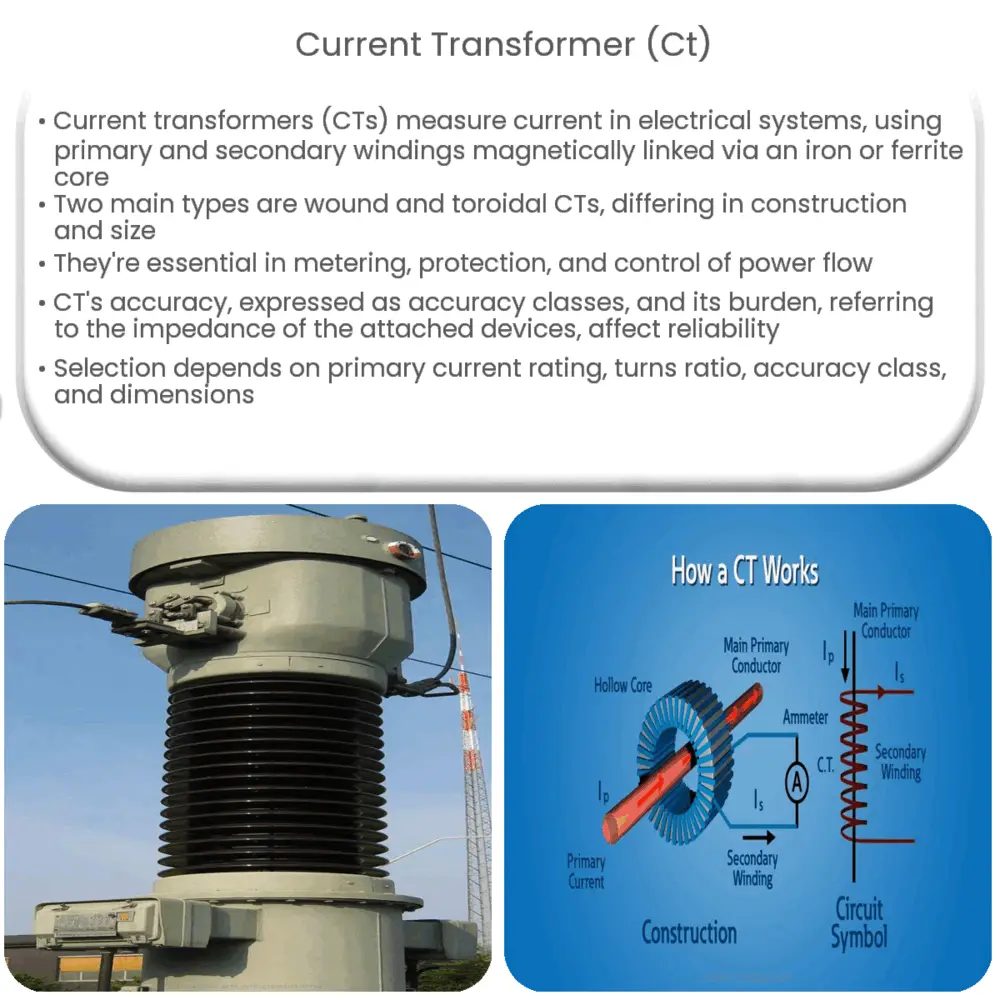Current transformers (CTs) are devices that measure high electrical currents by producing a proportional, lower current for safe monitoring and control.

Understanding Current Transformers (CT)
Introduction
Current transformers (CTs) are essential devices in the field of electrical engineering, playing a vital role in the measurement, control, and protection of electrical systems. These transformers are designed to safely and accurately measure the current flowing through power lines, enabling accurate monitoring and control of electrical networks. This article delves into the fundamentals of CTs, their applications, and their significance in the modern electrical landscape.
Basic Principles of Current Transformers
Current transformers operate based on the principle of electromagnetic induction. They consist of a primary winding and a secondary winding, which are magnetically coupled through a core made of iron or ferrite material. The primary winding carries the current to be measured, while the secondary winding produces a proportional current that can be safely measured by connected instruments.
The primary function of a CT is to scale down the high current in the primary winding to a lower current in the secondary winding, allowing for safe and accurate measurement. This scaling is achieved through the turns ratio between the primary and secondary windings. For example, if the primary winding has 1 turn and the secondary winding has 100 turns, the turns ratio is 1:100. In this case, if the primary current is 1000 A, the secondary current would be scaled down to 10 A.
Types of Current Transformers
There are two main types of current transformers: wound and toroidal. The primary difference between these types lies in their construction and the method used to couple the primary and secondary windings.
Wound CTs
Wound current transformers feature a primary winding that is directly wound onto the core, with the secondary winding wound on top of the primary winding. This construction allows for a strong magnetic coupling between the windings, which results in accurate current measurement. However, the physical size of wound CTs can be a limiting factor in certain applications.
Toroidal CTs
Toroidal current transformers, also known as “ring-type” or “window-type” CTs, have a ring-shaped core with the secondary winding uniformly wound around it. The primary conductor is passed through the center of the ring, forming a single-turn primary winding. This design enables a compact and lightweight construction, making toroidal CTs suitable for applications where space is limited.
Applications of Current Transformers
Current transformers are widely used in various applications, such as:
- Metering: CTs are used in conjunction with electrical meters to measure the current consumption of industrial, commercial, and residential customers. This enables utility companies to accurately bill their customers and monitor the load on the electrical network.
- Protection: In conjunction with protective relays, CTs provide critical information to detect faults and anomalies in the electrical system. This helps prevent damage to equipment and ensures the safety of personnel working with electrical systems.
- Control: CTs are used in control systems for monitoring and managing power flow, load shedding, and other aspects of power distribution and transmission.
Accuracy and Burden
Accuracy is a crucial aspect of current transformers, as it directly affects the reliability of the measurements. CT accuracy is typically expressed in terms of accuracy classes, such as 0.2, 0.5, 1, or 3, where the number represents the percentage error in the secondary current measurement.
The burden of a CT refers to the impedance of the connected measuring instruments and wiring. It is an essential factor to consider because excessive burden can lead to a reduction in accuracy. The burden is expressed in volt-amperes (VA) and should be matched with the CT’s rated burden to ensure optimal performance.
Selection and Installation
Choosing the right current transformer for a specific application involves several factors, including:
- Primary current rating: The CT should have a primary current rating that matches or exceeds the maximum current in the circuit to be measured.
- Turns ratio: The turns ratio should be selected to provide an appropriate scaling of the primary current to a safe and measurable secondary current.
- Accuracy class: The accuracy class should be chosen based on the requirements of the application, with higher accuracy classes providing better measurement precision.
- Physical dimensions: The size and shape of the CT should be considered to ensure proper installation and compatibility with the existing infrastructure.
When installing a current transformer, it is essential to follow proper safety guidelines and practices. The primary conductor should be de-energized before installation, and the CT should be securely fastened to prevent movement during operation. Additionally, the polarity of the CT connections should be carefully observed to ensure correct phasing of the measured current.
Conclusion
Current transformers are indispensable devices in the electrical industry, providing accurate current measurements, protection, and control for power systems. With a variety of types and configurations available, it is crucial to understand the fundamentals of CTs, their applications, and factors to consider when selecting and installing them. As the world continues to rely on complex electrical networks, the importance of current transformers in ensuring the safe and efficient operation of these systems cannot be overstated.

